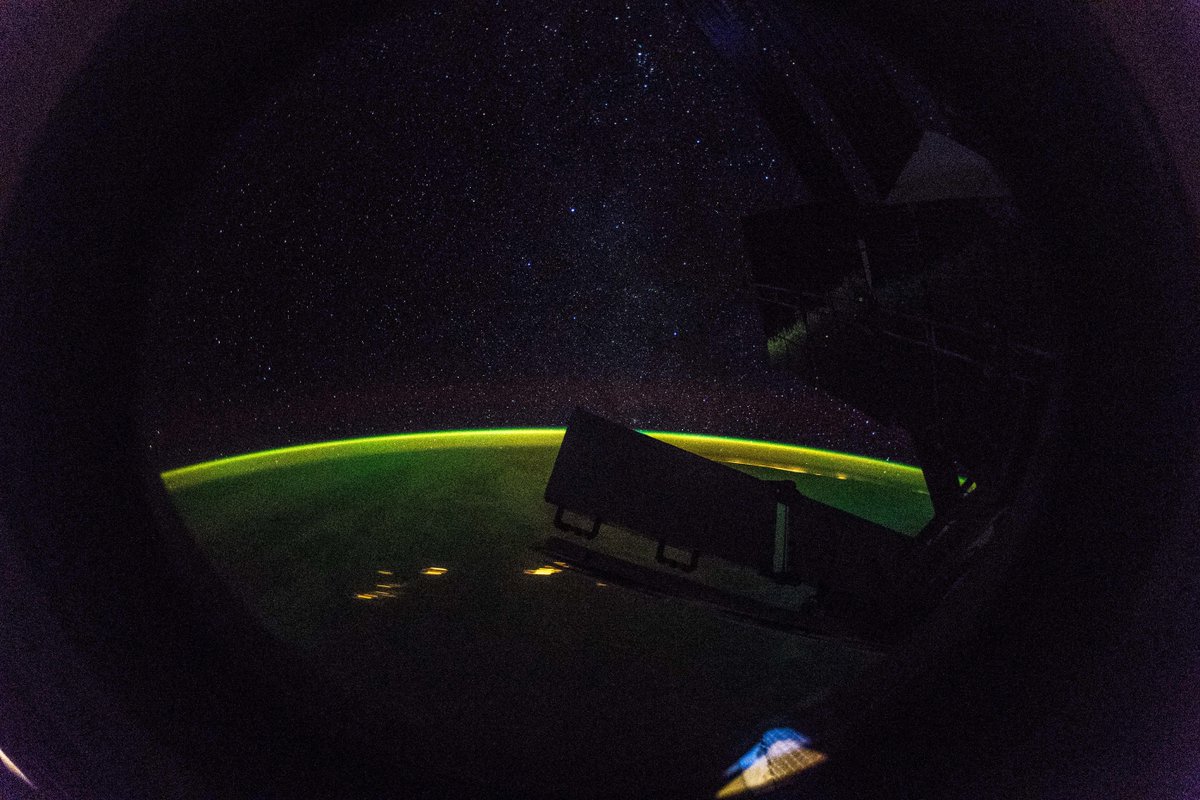[:ja]アレックス・ゲルスト宇宙飛行士がISSから撮影した夜の地球です。星空を背景に、緑色の大気光が広がっています。

大気光は大気光学現象の一種で、地球などの惑星の大気が起こす弱い発光です。通常夜間に観測されるので”nightglow”と呼ばれます。大気上層において、大気光は様々な反応によって発生します。例えば、日中の太陽光による光イオン化反応で生成されたイオンの再結合、上層大気に放射される宇宙線によるルミネセンス、酸素や窒素が、数百km上空で水酸化物イオンと反応することによる化学発光などです。太陽光の散乱があるため、これらは昼の間は観察することができません。
参考文献: Alex Gerst’s Tweet
地球俯瞰画像を見る: LiVEARTH
[Earthview Wonders] No.770: Nightglow
Astronaut Alex Gerst captured from ISS the nightglow. Green nigtglow spreads over the Earth on the back of starry night space.

Airglow (also called nightglow) is a faint emission of light by a planetary atmosphere. In the case of Earth’s atmosphere, this optical phenomenon causes the night sky to never be completely dark, even after the effects of starlight and diffused sunlight from the far side are removed. Airglow is caused by various processes in the upper atmosphere of Earth, such as the recombination of atoms which were photoionized by the Sun during the day, luminescence caused by cosmic rays striking the upper atmosphere, and chemiluminescence caused mainly by oxygen and nitrogen reacting with hydroxyl free radicals at heights of a few hundred kilometres. It is not noticeable during the daytime due to the glare and scattering of sunlight.
Reference: Alex Gerst’s Tweet
See earthview photo gallery: LiVEARTH[:en][Earthview Wonders] No.770: Nightglow
Astronaut Alex Gerst captured from ISS the nightglow. Green nigtglow spreads over the Earth on the back of starry night space.

Airglow (also called nightglow) is a faint emission of light by a planetary atmosphere. In the case of Earth’s atmosphere, this optical phenomenon causes the night sky to never be completely dark, even after the effects of starlight and diffused sunlight from the far side are removed. Airglow is caused by various processes in the upper atmosphere of Earth, such as the recombination of atoms which were photoionized by the Sun during the day, luminescence caused by cosmic rays striking the upper atmosphere, and chemiluminescence caused mainly by oxygen and nitrogen reacting with hydroxyl free radicals at heights of a few hundred kilometres. It is not noticeable during the daytime due to the glare and scattering of sunlight.
Reference: Alex Gerst’s Tweet
See earthview photo gallery: LiVEARTH[:]